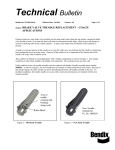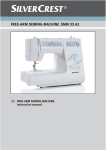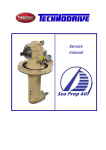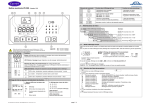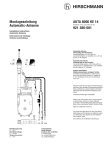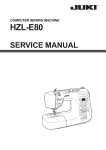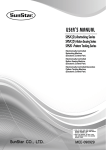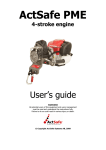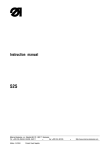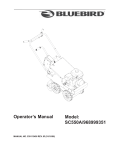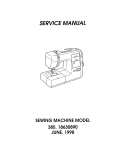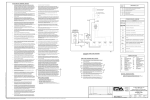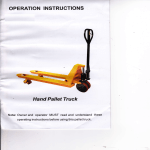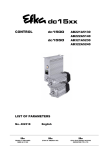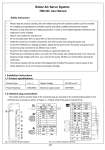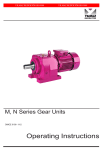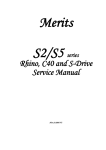Download Minerva 72317-101
Transcript
Service manual and parts list 317 - 101 Minerva Boskovice, a.s., Sokolská 60, 680 17 Boskovice, Czech Republic Member of Dürkopp Adler Group Tel.: +420-501-453434, 453433, 494111 Fax: +420-501-452165 Edition: 11/2005 Printed in Czech Republic http://www.minerva-boskovice.com S735 000038 72317 - 101 I SINGLE NEEDLE FREE ARM INDUSTRIAL SEWING MACHINE WITH LOWER OSCILLATING (NON-DROP LIKE) FEED IN COMBINATION WITH NEEDLE AND UPPER FEED, FOR HEMMING 72317 - 101 I 522 722 730 109 13 Use of Machine The machine is used for hemming shoe uppers made of natural or artificial leather or of textile. The hemming material can be leather, textile, and plastic. 1 72317 - 101 I Specifications Machine speed Stitch type Stitch length Stitching Needle Cotton threads Synthetic threads Hook Presser foot stroke Thickness of sewn work Stitching of transition sections (at reduced speed) Clear work space Free arm diameter Weight of machine head 3,000 stitches per min. at stitch length max. 4 mm 2,500 stitches per min. at stitch length 4 to 6 mm 2,500 stitches per min. with synthetic treads two-thread lockstitch 0 to 6 mm for textile materials 0 to 4 mm for leather only forward (for bartacking, a hand lever can be ordered as Equipment No. 203) 134 R Spec. hard chromium plated, Nos. 90 - 120 123 x 5 Spec., hard chromium plated, Nos. 90 - 120 Schmetz 797 CFCF Nos. 90 - 120 134 LGR, hard chromium plated, Nos. 90 - 120 29.5 tex x 3 - 14.5 tex x 3 PES 25 tex x 1 x 2; 25 tex x 1 x 3 C 235 with hand lever 7.5 mm with treadle 9 mm up to 4 mm for leather up to 6 mm for other materials for leather sections thickened up to 5 mm, with height difference of 2 mm for textile sections thickened up to 8 mm, with height difference of 2 mm 145 x 100 mm 42 mm 26.5 kg Technical description This free arm lockstitch hemming machine is equipped with a rotary hook with horizontal axis, mounted at the end of the free arm and driven from the lower shaft by a gearing with ratio of 2 to 1, the lower shaft being driven from the upper shaft by a drive belt with gear ratio of 1 to 1. The stitch length, steplessly adjustable from 0 to 6 mm, is controlled by a revolving knob situated on the vertical column of the machine arm. The machine is designed for forward stitching but can be equipped with a hand lever for reverse stitching (bartacking). The presser foot feed movement is derived from an eccentric mounted on the upper shaft. The drive is transmitted from the electric motor to the upper shaft by a V-belt. The right-side treadle controls the motor clutch, the left-side one, the presser foot lifting. The principal parts of mechanisms exposed to increased strain are seated in rolling contact bearings. The machine has a wick group lubrication and an automatic hook lubrication. Some lubrication places are oiled individually. For reasons of security, the machine is equipped with a V-belt guard and a thread take-up lever guard. In its basic version, the machine is supplied without lighting, but is fitted with a screw and washer to receive a suspensiontype lighting, available as Equipment No. 300. 2 72317 - 101 I Equipments and their Use Commercial designation Ordering No. 317 E 043 S791 317 E 046 S791 see table on page four Z 066 S791 Z 074 S791 317 Z 109 S722 Z 012 S794 Z 011 S794 124033 35 124046 35 995066 995074 730109 40 222012 222011 Name Basic hemming set Stitching set for stitching without hemming equipment Hemming equipments Attachment cpl. for hand wheel Parts for backtacking High mortality spare parts kit in a plastics box Halogen lighting (12 V, 20 W - contains transformer) Suspension-type lighting 3 72317 - 101 I Table of hemming equipments Type of material Equipment Ordering No. No. Width Production No. of hemming border equipments strip (mm) Suitable for hemming 317 N 007 317 N 008 317 N 028 317 N 029 S791 705007 S791 705008 S791 705028 S791 705029 8 10 14 16 049 064 049 253 049 254 049 560 Leather upper with lining Textile shoes for winter season Slippers Leather upper, edge of leg portion 317 N 009 S791 705009 8,5 - 9 049 276 Textile with selvedge 317 N 011 317 N 024 317 N 012 317 N 013 S791 705011 S791 705024 S791 705012 S791 705013 13 14 16 20 049 301 049 625 049 278 049 302 Textile upper with linning, up to 1.8 mm thick material Slippers Slippers, up to 1.7 mm thick material Insole, up to 3.8 mm thick material Insole, up to 2.8 mm thick material One-sided folded textile 317 N 014 317 N 015 S791 705014 S791 705015 8 11 049 306 049 307 Textile upper with lining, up to 1.7 mm thick material Double-sided folded textile 317 N 017 317 N 018 317 N 019 S791 705017 S791 705018 S791 705019 21 23 26 049 437 049 308 049 280 Textile upper with lining Textile shoes winter season, with warm lining 317 N 022 317 N 026 S791 705022 S791 705026 8 8 049 277 049 626 Leather and textile upper with lining For inserting binding made of "Chemlon" (a synthetic material) Upper leather Synthetic material 4 72317 - 101 I I. INSTRUCTIONS FOR SERVICING OF MACHINE A . General instructions 1. Read the instructions of the manual carefully and adhere to them. 2. During transport and while unpacking the machine, proceed in accordance with the instructions and marks on the packing. 3. Report any damage which has occured during transport to the railway authorities or to the forwarding agents at once. Immediately after unpacking, check the contents against the order and report any discrepancies to us. We cannot recognize claims submitted at a later date. 4. Having transported the machine to its work site, remove the preserving grease coating and all impurities from the machine head. make sure that no machine part has become loose and that its mechanism is free of any foreign body. 5. Lubricate the machine daily. Before lubrication, always check whether the lubrication places are clean. It is advisable to lubricate frequently in small quantities rather than conversely. With a hand oil can, drip oil into all the holes marked in red. Check the oil level on the oil level indicators on the machine arm. 6. Clean the machine daily, in particular the parts which become choked by impurities from the sewn material. During the cleaning, carefully check whether no machine part has become loose. 7. Once a week, during thorough cleaning, carefully check the whole machine to see that no parts are damaged and that all machine mechanisms operate correctly. Any faults ascertained must be repaired immediately. Once a year, general overhaul should be carried out. The machine should be dismantled, thoroughly cleaned, individual pieces as well as the parts of the electrical equipment inspected, faulty or worn out pieces repaired or exchanged. 8. Adhere to the safety regulations. Never clean the machine or repair defects until the machine is at rest. Do not remove covers or other safety devices. 9. The electrical equipment of the machine should be kept in a good and faultless state, in accordance with the electrotechnical and safety regulations. The lead - in cable, supplied as a part of the machine, has a corss sectio of 4 x 1 mm2, and must be protected accordingly in each phase. If the machine is provided with a plug make sure always before plugging in that all switches are off. Never try to repair any defects of the electrical equipment by ourself but call in an expert electrician. 10. We cannot assume any responsibility for the consequences resulting from the non-observance of these instructions. B. Packing, unpacking, cleaning and lubrication of machine 1. Packing of machine The machine head is seated in a separate case, the stand either in crating or in another case (for severe climate conditions). 2. Unpacking of machine When taking over the machine from the railway authorities or in the works ascertain whether it has arrived in good order. Report any damage which has occured during the transport to the railway authorities or to the forwarding agents immediately. The unpacking should be carried out carefully so as to prevent damage to machine parts. 5 72317 - 101 I Further check the accessories of the machine against the order and report any discrepancy immediately, as we cannot consider belated claims. 3. To set the machine on stand When unpacking the machine out of the box and when putting it from one place to another, always hold it by its arm. Remove the protective grease coating and possible impurities and check whether it has no loose parts or foreign bodies on it or in its mechanism. After the machine has been brought to its work site, set it on the stand and fasten it with four screws to be inserted from the lower side of the stand plate. Check the treadles for correct function, i.e., the right-side one for actuating the clutch of the electric motor, the left-side one for lifting the presser foot, after connecting the tie rod of the left-side treadle with the lifting mechanism. Screw out the two screws, remove the belt guard, put the V-belt on the motor pulley, mount the belt guard and fix it it with the screws. 4. To set and fix the machine The machine is designed as a stable unit with the stand, requiring no fixing to the floor. To make up for possible unevenness of the floor, use the levelling rubber piece situated on one of the stand legs and adjustable by means of turning a handwheel also mounted on the leg. 5. To clean and lubricate the machine (Figs. 1, 1a) Before putting the unpacked machine into operation, remove the protective grease coating and clean the machine thoroughly. Suitable oil for the machine and the hook is the white heavy vaseline oil with viscosity 50 mm2.s-1 at 20oC. Since the machine has a group wick lubrication, drop into the tank of the oil level indicator more oil than is usual in the individual lubrication of machine parts. The lubrication holes are marked with red circles around them. Before lubrication, check if the lubrication holes are clean, and clean them in case of need. It is advisable to oil the machine several times a day. The hook is oiled automatically from the oil tank located in the machine arm. Check the oil level on the oil level indicator and refill oil in time. The hook and its mechanisms should be cleaned several times a day. Remove the fluff with a fine brush, apply some drops of kerosene to all soiled parts of the hook and its surrounding mechanism, let the machine run at high speed, then stop it, wipe off flushed-out dirt, and oil the hook with its mechanism. This cleaning should be carried out daily, in particular after the end of the work shift, in order to prevent dirt from drying on the hook and its mechanism. Before proceeding to clean the machine, unthread it and take the hook bobbin out of the hook. Once a week, clean the machine thoroughly from all impurities and from settled oil. Fig. 1 Lubrication places: The two principal lubrication places are located on the upper cover of the machine arm. One of them is used to refill oil in the oil tank twice a week, to one half of the oil level indicator situated on the front part of the macarm. The other lubrication places are shown in the lubrication chart. 6 72317 - 101 I Warning ! Before proceeding to clean and lubricate the machine, be sure to switch off the main switch and hold your feet away from the machine stand treadles in order to avoid accidental machine start by treadle actuation. Fig. 1a 6. Amount of oil supplied for hook lubrication The oil coming by means of a wick prevents the hook hrom getting seized. After the machine has been put into service, check at regular intervals the oil level in the oil tank disposed on the machine arm. To observe: At the resumption of work after a relatively long interval, e.g., at the beginning of the morning shift, it is advisable first to remove the gathered supefluous oil from the hook, either by letting the machine run idly for a short period or by producing a few stitches, about 20 cm, on a test material, to prevent the sewn work from getting soiled by oil. 7 72317 - 101 I 7. Instalation and gearing lighting with transformer Gearing of lighting may be performed by a specialist - electrician with the machine unplugged from mains ! The lamp is assembled on the front part of arm by using the peg. The conductor is passed through a hole in the stand and after unscrewing the cover of the transformer it is plugged to 24 V screws and ensured with fastener. The cover of the transformer is screwed and the transformer is fastened with added screws o 4 x 25 into pre-drilled holes in the bottom side of the machine stand. We must make a hole in the motor clamp from the bottom side and screw the outlet P 16. The conductor is fastened under the installed fasteners and screwed to the transformer after passing through the outlet P16 and then it is screwed to the 2 bottom screws of the clamp. The cover of the clamp is screwed again. By using the added fasteners the conductor is fastened to the arm of the machine and the lamp is adjusted to the suitable position. Warning ! Avoid any intervention into the electrical equipment of the machine but call in an electrician. Unqualified intervention ivolves the risk of accident by electric shock. 8. Hand reverse sewing lever instalation (Fig. 2) It is possible to assembly the lever for hand controlled bartacking. We unscrew the screws /1/ and put off the cover of the belt. Then we slack the screw of the cradle /4/ through the hole in the arm. We shift the reverse sewing shaft towards the worker. By shifting hand lever /2/ we must be careful not to deform the cradle bar /3/. We can check the assembly by eye after unscrewing the rear cover /5/. We define the axial will of the lever and cradle, we adjust the lever to the same position as the machine and tight up the screw /4/. We test the sewing and screw up the cover of the belt. By pressing of the lever down, the sewing direction will be changed. After release the lever returns to previous position and the machine will sew in front direction. 3 5 4 2 Fig. 2 8 1 72317 - 101 I C. To prepare the machine for sewing 1. General inspection Inspect the machine thoroughly for loose parts as well as for the presence of foreign bodies. With the electric motor switched off, depress the right-side treadle and rotate the handwheel by hand to see whether it revolves freely and whether the machine is adjusted correctly. Further check for correct function: - the presser foot lifting with the left hand and with the left-side treadle - reverse stitching by means of the hand lever on the vertical column of the machine arm 2. Sense of rotaion The correct sense of rotation of the machine handwheel is anticlockwise, viewing the machine from the side of the handwheel. 3. Electrical equipment An electrician connects the machine to the mains 3 x 380 V, 50 Hz. Switch on the electric motor and check whether the pulley turns in the correct direction shown by the arrow on the cover of the electric motor, i.e., to the left, toward the operator. If this is not the case, the plug of the lead-in cable must be taken out and the cable must be switched over on the plug or on the terminal board of the electric motor. The incorrect sense of rotation of the pulley is inadmissible. Warning ! Avoid any intervention into the electrical equipment of the machine but call in an electrician. Unqualified intervention ivolves the risk of accident by electric shock. 4. V-belt and its tension (Fig. 3) The V-belt tension can be adjusted by displacing the electric motor in the groove of its holder after loos-ening the four clamping screws. The correct belt tension ensures transmission of full power with losses reduced to minimum. To check the tension of the V-belt, depress it lightly in the middle part between the handwheel and the motor pulley; if the belt tension is correct, the pressed-on part will yield some 20 mm sideways. Excessive tension of the Vbelt reduces machine output and increases both the power consumption and the wear of the bearings. Set the machine to its opera-tive position, check the V-belt for correct tension, and mount the belt guard. Before proceeding to any adjustment on the ma-chine, be sure that it is switched off. 5. To lift the presser foot The lifting and sinking of the presser foot is actuated by the left-side treadle. To lift the presser foot and to lock it in the lifted position, the hand lifting lever placed at the rear side of the machine arm can alsobe used. To sink the presser foot onto the sewn work, first slightly depress the left-side treadle so as to disengage the locking of the lifted presser foot. 9 Fig. 3 72317 - 101 I 6. Needles and threads The machine requires the use of needles 134, Schmetz 797 CFCF current sizes, hard chromium plated. Considering the high machine performance and the resulting needle heating, it is advised to use hard chromium plated needles. The size of the needle to be used depends on the size of the thread, since it must pass freely through the needle eye. It is advisable to choose a needle sufficiently big to permit free thread passage through the needle eye. Only high-class threads should be used, an S-twist one for a the needle, and an Z-twist one for the hook bobbin. A coarse thread or one which has to overcome considerable resistance when passing through the needle eye reduces the machine performance and increases its trouble incidence. With synthetic threads, it is necessary adequately to reduce the sewing speed and to use only hard chromium plated needles to improve heat dissipation from the area of the needle eye so as to avoid the risk of melting and breaking the synthetic thread. 7. To insert the needle (Fig. 4) 2 Switch off the motor, depress the right-side treadle, and rotate the handwheel towards you until the the bar reaches its top position, i.e., until the greatest possible distance between the needle holder and the throat plate has been obtained. Sink the presser foot on the sewn work, loosen the screw /1/ of the needle bar and insert the needle up to the stop, with its long groove to the left of the operator. (The correct insertion of the needle up to the stop can be visually checked in the transverse hole of the needle bar). Fix the correctly inserted needle by retightening the screw. Each time you inserted a new needle, check first whether it is straight in order to ensure that it will pass through the centre of the needle aperture provided in the feed-dog. Never use a needle chosen haphazardly but choose it with respect to the character of sewn work and to the thread size. 3 5 4 6 Warning ! Before proceeding to exchange the needle, be sure to switch off the main switch and hold your feet away from the machine stand treadles in order to avoid accidental machine start by treadle actuation. 8. 7 1 To thread the upper thread (Fig. 4) Put the bobbin on the bobbin stand, unwind a sufficient portion of it, and pass it through the Fig. 4 thread guide of the bobbin stand, then through the thread guides /2/, the adjusting spring, the thread guide /5/, into the eye of the thread take-up lever, downwards through the thread guide /6/, through the aperture of the needle bar and, from the left to the right, into the needle eye. Warning ! Before proceeding to thread the machine, be sure to switch off the main switch and hold your feet away from the machine stand treadles in order to avoid accidental machine start by treadle actuation. 10 72317 - 101 I 9. To take out the hook bobbin Set the needle bar to its top position, push away the hook cover, open the bobbin case lock, and take the bobbin case out. As long as the bobbin case lock is open, the bobbin is held in the case. Release the lock, turn the bobbin case upside down, i.e., with its open side downwards, and the bobbin will fall out. Warning ! Before proceeding to exchange the bobbin of the hook, be sure to switch off the main switch and hold your feet away from the machine stand treadles in order to avoid accidental machine start by treadle actuation. 10. To wind the hook bobbin (Fig. 5) 1 2 3 4 5 Fig. 5 To wind the hook bobbin, a bobbin winder, adapted to be mounted on the front side of the machine arm, is available on special order as Equipment No. 201. Lead the thread from the bobbin stand through the aperture provided in the bobbin stand arm, through the aperture of the thread guide /1/ between the braking discs /2/ then through the other apertures of the thread guide /1/ to the bobbin mounted on the winder shaft, and push the winder shaft. The winder is now operable and as soon as the machine is started, begins automatically the bobbin winding which the thread is evenly distributed along the whole of the bobbin width. As soon as the bobbin is fully wound, the stopstart lever springs off and the winder shaft automatically gets out of engagement, thus finishing the winding. 11 72317 - 101 I 11. To thread the lower (Fig. 6) 1 2 Put the fully wound bobbin into the bobbin case and insert the thread end into the notch of the bobbin case, then pass the thread end under the pressure spring /1/ of this bobbin case with the bobbin and with released lock. 12. To catch the lower thread With your left hand, grasp lightly the upper thread end without stretching Fig. 6 it. With your right hand, turn the handwheel towards you until the threaded needle reaches subsequently its bottom and top positions, thereby catching the lower thread. Draw then lightly the upper thread until the lower thread shows through the aperture of the feeddog, and lay the two thread ends behind the needle. When threaded, the machine may be started only after a bit of material has been inserted under the presser foot. Both when starting and when finishing the sewing, the thread take-up lever should be placed in its top position to avoid the risk that the upper thread will thread out and possibly catch in the hook course. 13. Sewing - the work proper Insert the material to be sewn under the presser foot and fix it by sinking the presser foot, then switch on the electric motor and depress gradually the right side treadle. In this way, the machine is set in motion and the sewing speed increases up to the maximum obtained when the treadle has reached its lowest position. By releasing the treadle, the clutch of the motor is disengaged, the electric motor braked, and the machine stopped. During the sewing, avoid pulling the amterial but guide it only. By pulling the material you bend the needle with the risk of breaking it in case of collisions with the edge of the needle aperture of the feed-dog. Repeated collisions of this kind make the needle aperture burr which, in its turn, causes thread ruptures. At the end of the sewing operation, set the thread take-up lever to its top position, raise the presser foot, and take the sewn work from under it. When observing the described sequence of actions, the machine is ready for next stitching. To observe: Having put the new machine in use, do not charge it fully from the very beginning. During the first two or four weeks, when the machine is running-in, increase its speed gradually from about 2,500 stitches per min. and check carefully its running. Throughout this time, pay special attention to the machine lubrication. By keeping to these rules you will obtain a long service life and perfect precision of the machine even at its full performance. II. INSTRUCTIONS FOR ADJUSTMENT OF MACHINE MECHANISMS This section describes adjustments of the type that can be carried out on the work site. Larger adjustments, requiring more time, should be carried out by a skilled sewing machine mechanician. 1. Stitch length adjustment (Fig. 5) The stitch length can be steplessly adjusted from 0 to 6 mm by turning the knob /4/ provided on the vertical part of the machine arm. By turning it to the right, you increase the stitch length, by turning it to the left, you reduce it. For easier handling, the reverse stitching hand lever should be slightly pressed downwards during the stitch length adjustment. 12 72317 - 101 I 2. Reverse stitching The reverse stitching is obtained by depressing the hand lever downwards. When released, the lever automatically resumes its previous position and thus restores the forward stitching. 3. Thread tension adjustment (Fig. 7, 7a) 2 The tension of the upper and the lower thread must be so interrelated that the stitch binding takes place in the median layer of the sewn material. To increase the upper thread tension, turn the nut /1/ to the right (clockwise), to reduce the tension, turn it to the left. To adjust the lower thread tension /4 Fig 7a/, use the screw provided in the middle part of the pressure spring of the bobbin case. By turning the screw /5/ to the right /to the left, you in crease/ reduce the pressure of the spring on the bobbin case between which and the spring the thread passes and, consequently, the lower thread tension. If the lower thread tension has been adjusted correctly, the adjustment of the upper thread tension will be sufficient, as a rule, to restore the desired quality of stitching. 4. 3 1 To adjust the presser bar pressure (Fig. 7) The pressure exerted by the presser foot is actuated by the adjusting screw /2/ accessibly located on the upper part of the machine arm. By turning it to the right/to the left, you increase/reduce the pressure. The pressure of the presser foot must be sufficient to provide for reliable and continuous feeding even at the top sewing speed. On the correct adjustment of the presser bar depends the uniformity of feeding of the sewn material as well as that of the stitch length. Excessive presser foot pressure results in excessive wear of the whole mechanism and in corresponding reduction in the service life of the machine. Fig. 7 4 Fig. 7a 13 5 72317 - 101 I 5. To adjust vertical stroke of the presser feet (Fig. 8) The vertical stroke of the presser feet is adjustable so as to meet the feed requirements imposed by various sewn work thickness, and the vertical stroke of the small feed foot is always greater than that of the big presser foot, depending on the sewn work thickness and on the width of the tape. To adjust the stroke, loosen the screw /1/ on the lever of the drive shaft and dispalce the lever either toward the operator, to reduce the stroke of the small presser foot, or away from the operator, to increase it. The stroke of the big presser foot, holding the sewn pushed to the throat plate, is inversely proportional to that of the small foot, i.e., the greater is the stroke of the small presser foot, the smaller of the big one. The total stroke range of the presser feet can be adjusted by displacing the pin of the connecting rod /3/ in the groove of the lever /2/. The lower is the position of the pin with respect to the pivot axis, the smaller is the total stroke range of the presser feet, and vice versa. 1 2 4 3 Fig. 8 14 72317 - 101 I 6. Feed-dog (Fig. 9a) The feed-dog must be properly seated and so fixed with the screws /1/ as to ensure that the needle passes through the centre of its needle aperture which must not be burred, damaged by thread or needle, or otherwise damaged, since any damage of this kind would unfavourably affect the quality of stitching. 1 Fig. 9a 0,2 - 0,3 mm 7. To adjust the feed-dog height above the throat plate (Fig. 9b) The height of the feed-dog teeth above the throat plate should be adjusted between 0.2 and 0.3 mm. For adjustment, first loosen the screw /1/ of the feed-dog support on the lower arm, then tighten the screw properly with a screwdriver. 1 Fig. 9b 15 72317 - 101 I 8. To adjust the movement of the needle and the feed foot Adjust the eccentric /4/ mounted on the upper shaft, see Fig. 8. 9. To adjust the needle bar height (Figs. 7 and 10) The hook must be so interrelated with the needle that at the moment when the hook point begins to take up the upper thread loop, the upper edge of the needle eye comes to lie about 1.5 mm under the hook point. If the needle bar height is not adequate to this requirement, loosen the respective screws, remove the front plate, loosen the scre of the needle bar carrier /3, Fig. 7/, adjust the needle bar height correctly, retighten the screw properly, and mount the front plate. (1,5) to 0,1 mm 2 Fig. 10 10. To adjust the hook course (Fig. 10) Set the stitch length at zero and turn the handwheel towards you until the needle bar reaches its bottom position and reascends by 2 mm. In this position, the hook point must be aligned with the needle axis, the distance between the hook point and the needle being 0.1 mm or less. If this is not the case, loosen the hook and set its position correctly, then retighten the screws and check the gap as well as the hook course. 11. To adjust the hook holder Set it so as to obtain a gap of about 0.7 to 0.9 mm between the holder lug and the bottom of the groove of the hook inner part. For this adjustment which is to be carried out only after the hook course adjustment, loosen the hook holder screws. 16 72317 - 101 I 12. To remove and to mount the drive belt (Fig. 11) Screw out the screws /1/, remove the upper belt guard /2/, take the V-belt from the handwheel groove, loosen the two screws, and take the handwheel together with the bearing /3/ from the machine arm and from the upper shaft. Pass the drive belt /4/ through the aperture thus created in the machine arm, along the upper shaft, and put it on the two belt wheels. Set the handwheel with its bearing back on the upper shaft in such an angular position that the first screw in the sense of rotation of the handwheel, when tightened, comes to about on the small flat surface provided on the upper sahft, then secure the handwheel with screws, mount the V-belt on the handwheel, mount the upper belt guard and fix it with screws. 3 4 1 2 1 Fig. 11 To observe: After each mounting or exchange of the drive belt, always adjust the hook course, as described in the preceding paragraphs of these Instructions. 13. To exchange the presser foot First raise the needle and, by means of the hand lever, the presser bar, to their top positions, then loosen the presser foot fixing screw and remove the presser foot. To insert the presser fooot, proceed in the same way. When the new presser foot is mounted check, in its lifted position, if the needle bar during its reciprocating movement does not collide with the presser foot. 17 72317 - 101 I 14. To adjust the feed step length Set the stitch length adjustment knob to its zero position, loosen the screw of the sleeve of the oblique cylinder, and set the ball bearing with the oblique cylinder in the sleeve so as to obtain zero eccentricity of the eccentric (visually, the connecting rod remains). Tighten the sleeve screw and check whether the feed step length is the same for forward and for reverse stitching. If not, readjust it in the above described manner. 15. To adjust the function of the adjusting spring (Fig. 12) To adjust the tension of the adjusting spring /1/, loosen the screw /2/ of the thread tensioner bushing /3/ and turn with screwdriver the pin /4/ of the thread tensioner either to the right, to increase the tension, or to the left, to reduce it, then retighten the screw /2/. To set the stroke of theadjusting spring, loosen the screw of the bushing and turn the bushing either to the left, to reduce the stroke, or to the right, to increase it. Retighten the screw and check the adjusting spring for correct function by producing on a test material a few stitches. Check also whether the thread, as it passes around the hook bottom, produces only a slight movement of the adjusting spring and is not tightened. 1 16. Electrical equipment of machine 3 The machine is driven by asynchronous motor with squirrel cage mounted on the stand. To reverse the sense of rotation, change-over the lead-in cable either at the plug or at the terminal board of the motor. T o o b s e r v e: Any failure of the electrical equipment should be repaired by a skilled electrician. Warning ! Avoid any intervention into the electrical equipment of the machine but call in an electrician. Unqualified intervention involves the risk of accident by electric shock. 4 5 6 2 Fig. 12 17. To adjust the opening of the upper thread tensioner (Fig. 12) The opening of the upper thread tensioner is actuated by means of a lever /5/ cooperating with a pin /6/ acting on a splice plate releasing an extension spring. If the opening fails to function, the whole thread tensioner is to be pushed some way into the machine, after the loosening of the screw /2/ in the machine arm. The gap between the thread tensioner discs, when opened, must provide for unobstructed thread passage. 18 72317 - 101 I 18. Assembly and adjustment of the folder (Fig. 12a) After fixing the folder on the plate by using the two screws bass and nuts it is possible to shift the folder to adjust required distance from the edge of bind. The distance is smaller by shifting to the left and bigger by shifting to the right. By turning aside the folder it is possible to fine adjust the distance between the needle and the folder in ord e r to create enough space for sewn material. This adjustment influences accurate leading of the bind to sewn materials. Binding is the sewin operation which quality depends not only on folder production and sewn material but also on skilfulness of worker. That's why we recommend to submit sewing samples and consultation with Minerva workers before the agreement signature. Fig. 12a 19 72317 - 101 I III. MAINTENANCE 1. Machine cleaning Plain machine lines help to keep clean outer machine parts. From time to time, it is necessary to remove waste between the feed-dog and the throat plate. Otherwise, the machine should be cleaned daily. Warning ! Before proceeding to clean and lubricate the machine, be sure to switch off the main switch and hold your feet away from the machine stand treadles in order to avoid accidental machine start by treadle actuation. 2. General overhaul and repair of machine It should be carried out once a year. The machine should be set out of operation, cleaned, dismantled, faulty pieces eschanged and due repairs carried out. The machine should be then assembled and tested. The electric motor and the electrical equipment of the machine should be inspected and tested. The general overhaul and repair of the machine should be carried out so thoroughly as to enable the machine to run without major defects for the next year. 3. To store the machine After the machine has been set out of operation, it should be thoroughly cleaned, inspected, and faulty pieces exchanged, if any. The machine should be then tested, coated with portective grease, and stored with all the tools and accessories. 20 72317 - 101 I V. FAULTS AND HOW TO REMOVE THEM Fault Cause a) Heavy machine run. The machine has been out of use for considerable time; dried oil and impurities deposited in the bearings. Inject some drops of kerosene into all lubrication holes and on the sliding surfaces and let the machine run rapidly so as to clean the lubrication holes in the bearings. Then oil the machine carefully with sewing machine oil. b) Slow machine start. Insufficient belt tension. Increase the tension by displacing the electric motor. c) Upper thread breakage. 1. Slashed thread guides. 1. Ascertain and exchange them. 2. Too sharp hook point. 2. Reapir it. 3. Faulty upper thread guiding or faulty needle threading. 3. Thread the upper thread correct (see par. 8, page 10). 4. Incorrect upper thread tension. 4. Adjust it (see par. 3, page 13). 5. Bad needle quality or bent needle. 5. Exchange the needle (see par. 7, page 10). 6. The thread size is inadequate to the thickness of sewn material. 6. Use adequate thread. 7. Machine considerably soiled. 7. Unscrew the throat plate, clean the mechanism, and set the throat plate. 8. Thread rests wound on the hook. 8. Remove the thread rests. 9. The thread is too thin or not strong enough. 9. Use adequate thread. 10.Damaged needle aperture of the feed-dog. 10. Amend or exchange the feeddog. 1. The thread is incorrectly threaded into the bobbin case. 1. Thread it correctly (see par. 11, page 12). 2. The thread is too thin or not strong enough. 2. Use adequate thread. 3. The thread is wound incorrectly on the bobbin. 3. Wind it on the bobbin correctly. d) Lower thread breakage. Remedy 21 72317 - 101 I Fault e) Skipped stitches. f) Needle breakage. Cause Remedy 4. Damaged bobbin. 4. Exchange it. 5. Too sharp pressure spring on the bobbin case. 5. Exchange the spring. 1. Needle inserted incorrectly. 1. Insert it correctly (see par. 7, page 10). 2. Blunt or bent needle. 2. Exchange it (see par. 7, page 10). 3. Slashed or broken hook point. 3. Exchange the hook. 4. Excessive needle aperture in the feed-dog. 4. Exchange the feed-dog (see par.6, page 15). 5. Broken adjusting spring for up per thread tension. 5. Exchange the spring and adjust the upper thread tension (see par. 15, page 18). 6. Needle bar positioned too high or too low. 6. Adjust it (see par. 9, page 16). 7. Overturned hook, incorrect hook course. 7. Adjust the hook course (see par. 10, page 16). 8. Soiled hook mechanism. 8. Clean it with kerosene. 1. Feed-dog positioned too low. 1. Adjust it in height (see par. 7, page 15). 2. Faulty attendance - pulling the material. 2. Let the material pass freely. 3. Needle too thin with respect to sewn work. 3. Exchange the needle (see par. 7, page 10). 4. Needle inserted incorrectly. 4. Insert it correclty (see par. 7, page 10). 5. Loosened feed-dog. 5. Check and fix it. 6. Excessive upper thread tension. 6. Adjust it (see par. 3, page 13). 22 72317 - 101 I Fault g) Heavy and irregular feeding. h) Stitch forming below sewn material. i) Stitch forming above sewn material. Remedy Cause 1. Feed-dog positioned too low. 1. Adjust it in height (see par. 7, page 15). 2. Worn-out feed-dog. 2. Exchange it. 3. Insufficient presser foot pressure. 3. Increase the pressure (see par. 4, page 13). 1. Tensioner discs damaged by upper thread. 1. Exchange them and adjust the upper thread tension (see par. 3, page 13). 2. The thread does not pass smoothly around the hook or catches the bobbin case. 2. Clean the hook and adjust the bobbin case. 3. The upper thread is not threaded between the tensioner discs. 3. Thread it correctly (see par. 8, page 10). 4. Thread broken and caught between the tensioner discs. 4. Clean the thread tensioner and adjust it (see par. 3, page 15). 5. Incorrect proportion between the tensions of upper and lower threads. 5. Correct the proportion and check it from time to time (see par. 3, page 13). 1. Damaged spring on the bobbin case, the lower thread is braked insufficiently. 1. Exchange the spring. 2. The lower thread is not threaded under the spring of the bobbin case. 2. Thread it correctly. 3. Broken thread caught under the spring of the bobbin case. 3. Remove the thread. 4. Incorrect proportion between the tensions of upper and lower threads. 4. Correct the proportion (see par. 3, page 13). 23 72317 - 101 I Fault Cause Remedy j) Locked hook. Thread rests caught in the hook. Rotate the handwheel in both directions regardless of the considerable resistance until the caught thread rests are cut to pieces. Remove them and start the unthreaded machine. Let it run for a period, then drip two or three drops of sewing machine oil on the hook, and finally check the position of the overload release clutch. k) Bad function of hemming equipment. Correct it (see par. 18, page 19). V. HOW TO USE THIS CATALOGUE AND ORDER SPARE PARTS For effective of the Catalogue, carefully study the following information: The Catalogue is divided into two sections: 1. 2. Instructions for servicing with figures and technical data Tables of spare parts with spare part list Please, specify in each order for spare parts: a) b) c) machine type and its production No. the twelve-digit No. of the part number of parts 24 317 - 101 tab. 1 2 3 4 5 6 7 8 9 10 11 12 13 14 15 16 17 18 19 20 S080 S080 S080 S080 S080 S080 S321 S321 S080 S080 S080 S080 S080 S080 S080 S080 S080 S980 S080 120233 721181 831478 120409 123117 831442 001000 003000 945100 945188 831456 111251 272039 111247 271462 132153 120266 025287 415024 22 23 S080 126069 S311 733620 317 - 101 tab. 2 1 2 3 4 5 6 7 8 9 10 11 12 13 14 15 16 17 18 20 21 22 23 24 S080 123117 S080 313204 S980 041168 S080 161138 S080 945358 S080 945316 S283 002001 ø 3,5/ø 4,8 x 100 mm S283 002001 ø 3,5/ø 4,8 x 250 mm S283 002001 ø 3,5/ø 4,8 x 290 mm S283 002001 ø 3,5/ø 4,8 x 360 mm S283 002001 ø 3,5/ø 4,8 x 280 mm S708 130002 ø 2 x 180 mm S708 130002 ø 2 x 200 mm S708 130002 ø 2 x 150 mm S708 130002 ø 2 x 300 mm S708 130002 ø 2 x 330 mm S708 130002 ø 2 x 400 mm S708 130002 ø 2 x 320 mm S080 111251 S080 421352 S321 001000 S562 411000 S562 260000 317 - 101 tab. 3 1 7 8 9 10 S283 002001 ø 3,5/ø 4,8 x 150 mm S708 130002 ø 2 x 300 mm S080 328005 S080 111247 S980 044726 S708 130002 ø 2 x 80 mm S980 044702 S080 945328 S980 021343 S080 122008 12 13 14 15 16 17 18 19 20 21 22 23 24 25 26 S080 S080 S080 S080 S080 S080 S080 S980 S080 S080 S080 S980 S080 S080 S080 28 S080 120006 32 S283 002001 ø 3,5/ø 4,8 x 90 mm S708 130002 ø 2 x 150 mm 2 3 4 5 6 33 124050 337043 646137 824367 120296 953191 945077 044907 953052 391158 120530 035501 111238 112015 138009 317 - 101 tab. 4 1 2 3 4 5 6 7 8 9 10 11 12 13 14 15 16 17 18 19 20 21 22 23 24 25 26 27 28 29 30 31 32 33 34 35 36 37 38 S080 349159 S311 000220 S283 002001 ø 3,5/ø 4,8 x 100 mm S708 130002 ø 2 x 150 mm S080 630256 S080 112014 S080 328110 S080 384075 S080 120222 S080 825791 S080 263145 S980 035538 S080 318103 S080 141088 S080 413340 S080 152080 S080 120226 S311 733280 S080 338191 S080 141102 S080 627171 S324 512900 S080 613486 S080 630257 S080 570058 S080 111247 S080 814327 S080 122029 S311 733300 S324 060093 S080 120006 S080 120216 S272 032015 S980 045328 S080 511099 S708 130003 ø 3 x 20 mm S980 045388 S272 225001 10 x 1300 mm 317 - 101 tab. 5 1 2 3 4 5 6 7 8 24 S080 120295 S080 630255 S080 413342 S080 111229 S080 342260 S080 413341 S080 613488 S283 002001 ø 3,5/ø 4,8 x 100 mm S080 335115 S708 130002 ø 2 x 20 mm S080 120226 S080 328110 S080 120296 S080 328179 S080 161142 S080 190346 S708 130002 ø 2 x 200 mm S080 630254 S080 274090 S080 392108 S080 612347 S080 322271 S708 001001 ø 1 x 120 mm S080 613491 26 27 28 29 S311 S080 S080 S080 9 10 11 12 13 14 15 16 17 18 19 20 21 22 23 733220 630256 338191 112014 317 - 101 tab. 6 1 2 4 5 6 7 8 9 10 11 12 13 14 15 16 17 18 19 20 21 22 23 24 25 S080 120342 S080 271436 S080 S080 S080 S080 S080 S080 S080 S080 S080 S080 S980 S080 S080 S080 S080 S080 S080 S080 S980 S080 S080 S080 111247 410573 392108 136023 615021 839053 120227 623205 274090 274084 044851 120233 613487 384077 131333 152080 263217 120550 048955 825511 120230 190359 317 - 101 tab. 7 1 2 3 4 5 6 7 8 9 10 11 12 13 14 10 16 17 18 20 S080 316101 S080 156040 S080 260497 S980 044853 S283 002001 ø 3,5/ø 4,8 x 90 mm S708 130002 ø 2 x 150 mm S080 612347 S080 274090 S080 392108 S080 392106 S080 120296 S080 630254 S080 328179 S080 322271 S708 001001 ø 1 x 120 mm S080 613491 S080 120410 S980 044907 S708 130002 ø 2 x 20 mm 317 - 101 tab. 8 1 2 3 8 9 10 S980 044907 S080 839291 S708 130002 ø 2 x 100 mm S080 422218 S080 413331 S708 130002 ø 2 x 200 mm S283 002001 ø 3,5/ø 4,8 x 100 mm S080 111247 S080 310270 S080 111227 12 13 S080 120266 S315 264294 15 16 17 18 19 20 S080 S980 S080 S080 S980 S980 4 5 6 7 828079 828080 262074 195041 171037 025244 317 - 101 tab. 9 2 3 4 5 6 7 8 9 10 11 12 13 14 15 16 S080 839291 S708 130002 ø 2 x 100 mm S080 422218 S080 120226 S708 130002 ø 2 x 200 mm S080 120425 S080 613486 S080 413340 S708 130002 ø 2 x 150 mm S080 413331 S080 111247 S080 328110 S080 613492 S708 130002 ø 2 x 20 mm S283 002001 ø 3,5/ø 4,8 x 100 mm 317 - 101 tab. 10 1 2 3 4 5 6 7 8 9 10 11 12 13 14 15 16 17 18 S980 044822 S080 613490 S080 120295 S080 120246 S080 627171 S080 328110 S708 130003 ø 3 x 20 mm S080 141102 S080 384075 S080 161142 S080 192061 S080 441187 S980 043029 S080 120218 S080 342258 S080 233051 S080 112013 S080 264326 317 - 101 tab. 11 2 4 5 6 7 8 9 10 11 S080 120014 S080 S080 S080 S980 S080 S080 S080 S080 126110 120226 646162 057011 111247 313301 831443 123117 317 - 101 tab. 12 2 3 4 5 6 7 8 9 10 11 12 13 14 15 16 17 18 19 20 21 22 23 24 25 S080 120014 S080 335114 S080 648109 S080 744409 S080 124050 S080 120059 S080 744410 S080 111247 S080 341218 S080 413335 S080 337087 S080 635175 S080 120230 S708 130002 ø 2 x 90 mm S080 120071 S080 436035 S708 130002 ø 2 x 80 mm S080 413333 S080 613493 S080 120226 S080 613492 S080 328110 S708 130002 ø 2 x 20 mm S080 120457 317 - 101 tab. 13 1 2 3 S080 172014 S080 190614 S980 041270 5 S080 953192 7 8 9 10 11 12 S080 S080 S080 S080 S080 S080 172016 195041 262040 328178 124050 744409 317 - 101 tab. 14 1 2 3 8 5 6 7 8 10 11 12 13 14 15 S080 111229 S080 413343 S708 130002 ø 2 x 330 mm S283 002001 ø 3,5/ø 4,8 x 290 mm S080 342259 S080 551154 S080 122007 S080 422213 S080 S080 S080 S080 S272 S980 120216 814327 554093 122029 032015 045504 317 - 101 tab. 15 3 4 5 6 7 8 9 10 11 12 13 15 16 17 18 19 20 21 22 23 S080 120403 S080 647229 S324 840271 S080 111251 S080 413332 S708 002105 ø 1,5 x 120 mm S080 111247 S080 340164 S080 945323 S080 551155 S311 122007 S080 413334 S283 002001 ø 3,5/ø 4,8 x 280 mm S708 130002 ø 2 x 320 mm S080 424051 S283 002001 ø 3,5/ø 4,8 x 250 mm S708 130002 ø 2 x 300 mm S080 120226 S080 436355 S080 120006 317 - 101 tab. 16 1 2 5 6 7 8 9 10 S080 635272 S080 120248 S080 S980 S980 S080 S080 S080 331162 057138 048955 120550 190359 120259 317 - 101 tab. 17 1 2 3 4 5 6 7 8 9 S980 S080 S080 S080 S080 S080 S080 S080 S080 035540 945294 316102 825963 190347 161163 123117 941119 120227 317 - 101 tab. 18 1 2 3 4 5 6 7 8 9 10 11 12 13 14 15 16 17 18 19 20 21 22 23 24 25 26 27 28 S980 S080 S080 S080 S321 S080 S311 S080 S080 S080 S080 S323 S311 S311 S080 S980 S080 S080 S324 S080 S080 S311 S980 S980 S080 S080 S080 S080 036097 131163 416135 442336 953200 265037 732014 161137 551047 613179 120252 081210 515095 515089 264243 049501 335108 424075 870000 410641 260378 733181 025249 025249 827194 260510 163106 161138 317 - 101 tab. 19 S522 000235 1 2 3 4 5 6 7 8 9 10 S522 S522 S522 S522 S522 S522 S080 S522 S522 S522 006008 000006 006010 006036 005227 005404 685017 005413 005229 005406 317 - 101 tab. 20 S791 995140 /1 1 2 3 4 5 6 7 S080 S080 S080 S080 S321 S080 S413 141168 190441 836381 953206 953251 826387 100130 317 - 101 tab. 21 S791 995140/2 1 2 3 4 5 6 7 S080 S080 S080 S080 S321 S080 S443 131333 384076 839175 141307 336002 381148 000006 317 - 101 tab. 22 S791 995140/3 3 4 5 6 7 8 9 10 11 12 13 14 15 16 17 18 19 S443 S080 S080 S080 S080 S080 S080 S080 S080 S080 S080 S080 S080 9205 S080 0223 S080 000006 161142 382098 141129 826298 191108 141133 613561 141123 318069 342136 141141 264159 102788 416146 000486 383022 317 - 101 tab. 23 S791 995140/4 1 2 3 4 5 6 7 8 S981 0077 0077 9330 0791 0791 0791 0791 036162 110220 110230 000177 001081 580100 001091 001096 10 0995 340617 2x 2x 2x 317 - 101 tab. 24 S791 995140/5 1 3 4 5 6 7 8 9 10 S413 731023 S548 9081 S080 S413 S413 S562 S080 S980 001000 500010 813481 000500 000400 002000 829796 092220 317 - 101 tab. 25 1 2 3 4 5 6 7 8 9 S980 S080 S321 S315 S522 S522 S273 S080 S522 092235 265037 953200 264294 006010 000006 025410 685017 006008 4x 2x 4x 4x 4x 4x 10 x 4x 317 - 101 tab. 26 317 E 043 S791 124043 35 1 2 3 4 5 S080 667134 S080 667166 134 No. 110 - 11 x S080 811638 S080 651483 317 - 101 tab. 27 317 E 046 S791 124046 35 1 2 3 4 5 6 S080 667141 S080 667142 134 No. 110 - 11 x S980 061210 S080 811656 S080 651479 317 - 101 tab. 28 1 317 N 007 S791 705007 S980 049064 1 317 N 008 S791 705008 S980 049253 1 317 N 028 S791 705028 S980 049254 1 317 N 029 S791 705029 S980 049560 1 317 N 009 S791 705009 S980 049276 1 317 N 011 S791 705011 S980 049301 1 317 N 024 S791 705024 S980 049625 1 317 N 012 S791 705012 S980 049278 1 317 N 013 S791 705013 S980 049302 317 - 101 tab. 29 1 317 N 014 S791 705014 S980 049306 1 317 N 015 S791 705015 S980 049307 1 317 N 017 S791 705017 S980 049437 1 317 N 018 S791 705018 S980 049308 1 317 N 019 S791 705019 S980 049280 1 317 N 022 S791 705022 S980 049277 1 317 N 026 S791 705026 S980 049626 317 - 101 tab. 30 Z 066 S791 995066 1 2 S080 511109 S080 120352 317 - 101 tab. 31 Z 074 S791 995074 1 2 3 4 5 6 7 S080 S080 S080 S080 S980 S080 S980 120295 635271 343096 274097 057211 120550 057212 tab. 32 317 - 101 317 Z 109 5x S080 120014 3x S080 141088 5x 3x 3x 5x S080 123117 S080 265037 S080 120530 S080 126110 1x 3x S080 124050 5x 3x S522 000006 S080 120410 S080 120342 S080 264243 3x 5x 1x 1x 3x S080 122029 S315 264294 3x S522 000235 5x S522 006008 S522 006010 S980 025244 S722 730109 40 317 - 101 tab. 33 Z 012 S794 222012 1 2 3 4 5 S080 S080 0798 0907 9822 120692 190346 500088 487519 510001 317 - 101 tab. 34 Z 011 S794 222011 1 2 3 4 5 6 7 8 9 10 11 12 13 14 15 16 17 18 19 20 21 22 23 24 25 26 27 28 29 S345 S980 S080 S080 S080 S080 S080 S080 S341 S345 S980 S080 S080 S080 S347 S321 S980 S080 S080 S080 S273 S080 S080 S080 S080 S735 S345 S980 S345 008000 091660 831506 441501 126085 441502 441570 841541 028052 201000 091814 120279 190347 839169 002000 001000 057091 141154 330088 161163 006001 141265 120261 824095 225018 975176 620040 091816 005000 8 x



























































